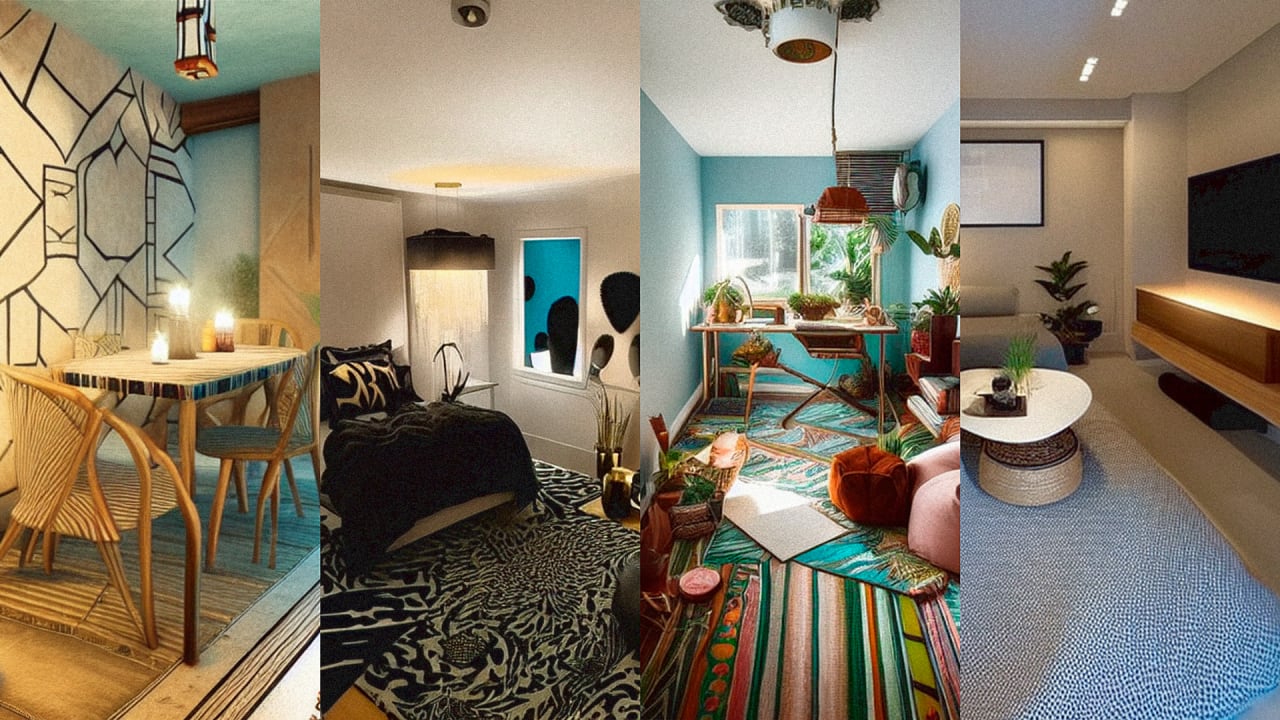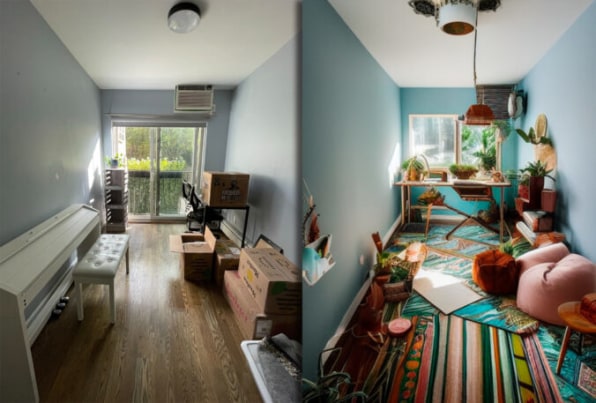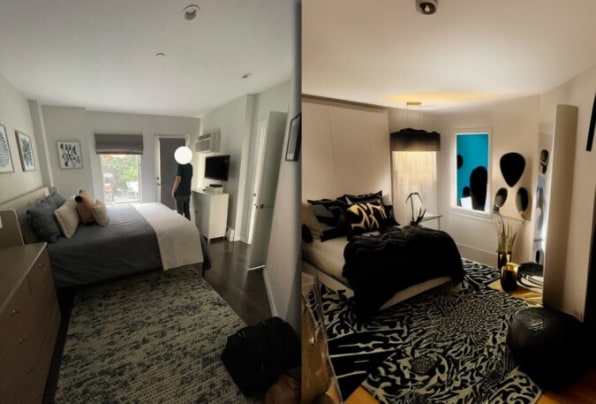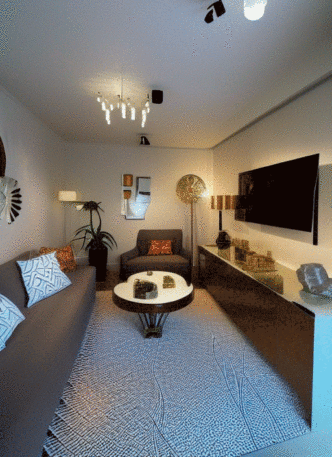
It’s been six weeks since my husband and I crammed 40 moving boxes into our new apartment in Brooklyn — and not a single room looks finished. The problem is two-fold: we have an unusual layout that’s split across two floors, and too many ideas for how each room should be laid out. Can we squeeze in soft seating in the upstairs dining room and stick to watching TV in the downstairs living room? How do we maximize the small open kitchen without ripping everything out and starting anew? Can the home office fit my desk, my piano, and a convertible sofa -bed, and how should each of these be positioned without it looking like a giant version of that bowl of miscellaneous stuff we all have at home?
 [Image: courtesy of the author]
[Image: courtesy of the author]
Burdened with so many questions and too many imperfect answers, I was intrigued when I learned about InteriorAI, a new AI image generator platform that lets you upload an image of your home (or someone else’s home plucked from the web), then generates a new look and layout based on one of 17 preselected styles. A “tropical” living room? Yes please! A “maximalist” home office? Why not!
Interior AI was created by an entrepreneur who goes by just levelsio. He’s also behind another AI platform that lets you “design” a brand-new house with the click of a button. It’s part of a growing yet controversial ecosystem of AI image generators like DALL-E and Midjourney, which use artificial intelligence to produce images out of thin air based on a few words, or in this case, a few basic selections. Much like those platforms, InteriorAI could become an intriguing new tool for interior design ideation, or even real estate virtual staging. But if my experience trialing it over the past few days is any indication, it could never replace the creative insight — and listening skills — of real humans trained as architects. At least not yet.
The first room I uploaded on the platform was my problematic dining room, which I chose to render in a Bohemian style. Though I forgot to specify this was a dining room and the program rendered a living room instead, the results were captivating: The AI picked up on the built-in bench that runs along my back wall and extended it around the corner, creating a cozy nook blanketed with colorful pillows and macramée plants hanging from the ceiling. The floor was covered with overlapping rugs and a hodge-podge of coffee tables and poufs with blurred edges betraying the current limitations of the software.
It wasn’t what I was looking for, but I was hooked, and I repeated the process with other styles (this time ensuring I specify that I’m after a dining room). The “’Cyberpunk”’ version illustrated a Tron-like image of my dining room where the built-in bench was metamorphosed into a sort of floor-to-ceiling, glossy white unit punctuated with bizarre neon lights. The “’Tribal”’ version did away with the bench completely, plastered geometric wallpaper on the back wall, and put a bamboo table and chairs (or was it wood?) topped with romantic glowing candles (or maybe they were lamps?)
 [Image: courtesy of the author]
[Image: courtesy of the author]
Hungry for more yet still dissatisfied with the inconclusive results, I inputted a photo of my home office, then of the downstairs living room, then of the bedroom. Each version spat out a version of my home that looked mega cool at first and mega impractical upon closer inspection. The “Bbohemian” home office made me wonder if I should move my desk to face the window (instead of the wall next to it), but the rest of the furniture was nothing but a jumble of poufs and mashups between wicker baskets and plant pots, with no regard for other typical home office furniture items like a bookcase, or a floor lamp, let alone the piano that featured in the original photo. And the “Ski chalet” version of the bedroom was completely disfigured with a different layout, no windows, and a horrendous blob of patterned carpets.
Some of the options are too weird or too incongruous to suggest the app will be replacing interior designers any time soon, but it is a way to get a broad sense of different stylistic ideas to draw inspiration from for a design. I learned that I hate a clean, modern look, and gravitate towards more “Bbohemian,” textured styles. I also came away with inspiration and new ideas I intend to explore, like moving my desk against that window, or layering a few rugs, but I also worry that my brain is now cluttered with unrealistic visions of my home, not to mention the unsettling fact that I could end up living in a machine’s version of the perfect home.
 [Images: courtesy of the author]
[Images: courtesy of the author]
The program’s creator has published an entire page about why he’s unreachable and therefore not open to interviews (reasons include “life is too short” and the pursuit of distraction-free deep work), but his Twitter page suggests he’s filled with client requests he fields in a couple of hours then uploads on the platform. One of those updates, dated October 5, allows people who upload empty rooms to get a fully rendered version with predefined interior objects based on the room style. Another one lets users manually mask any structural room changes the AI spits out (like a wall in lieu of a window), which levelsio says will eventually be made automatic.
All of this to say that InteriorAI is very much in its infancy. But in just one week, it has evolved from a free platform with unlimited renders and a dozen rooms to choose from, to a hybrid version with very few freebies and an option to pay $34 a month (as of this writing) for unlimited, “higher quality, more accurate renders” and the possibility to request new styles, according the website. (Since launch day on October 1, levelsio has added more rooms like an attic, a kitchen, and an outdoor patio to the portfolio, but all of these are now part of the paid version.)
I’m desperate for kitchen ideas as well and may well end up giving into a monthly subscription. But no matter the number of unlimited, high-res options it will bombard me with, I know it won’t even hold a candle to the half-hour brainstorming session I had with designer friend last night who went to bed after studying the plan of the apartment, and still cared about finding a solution in the morning.
* This article was originally published here
Comments
Post a Comment